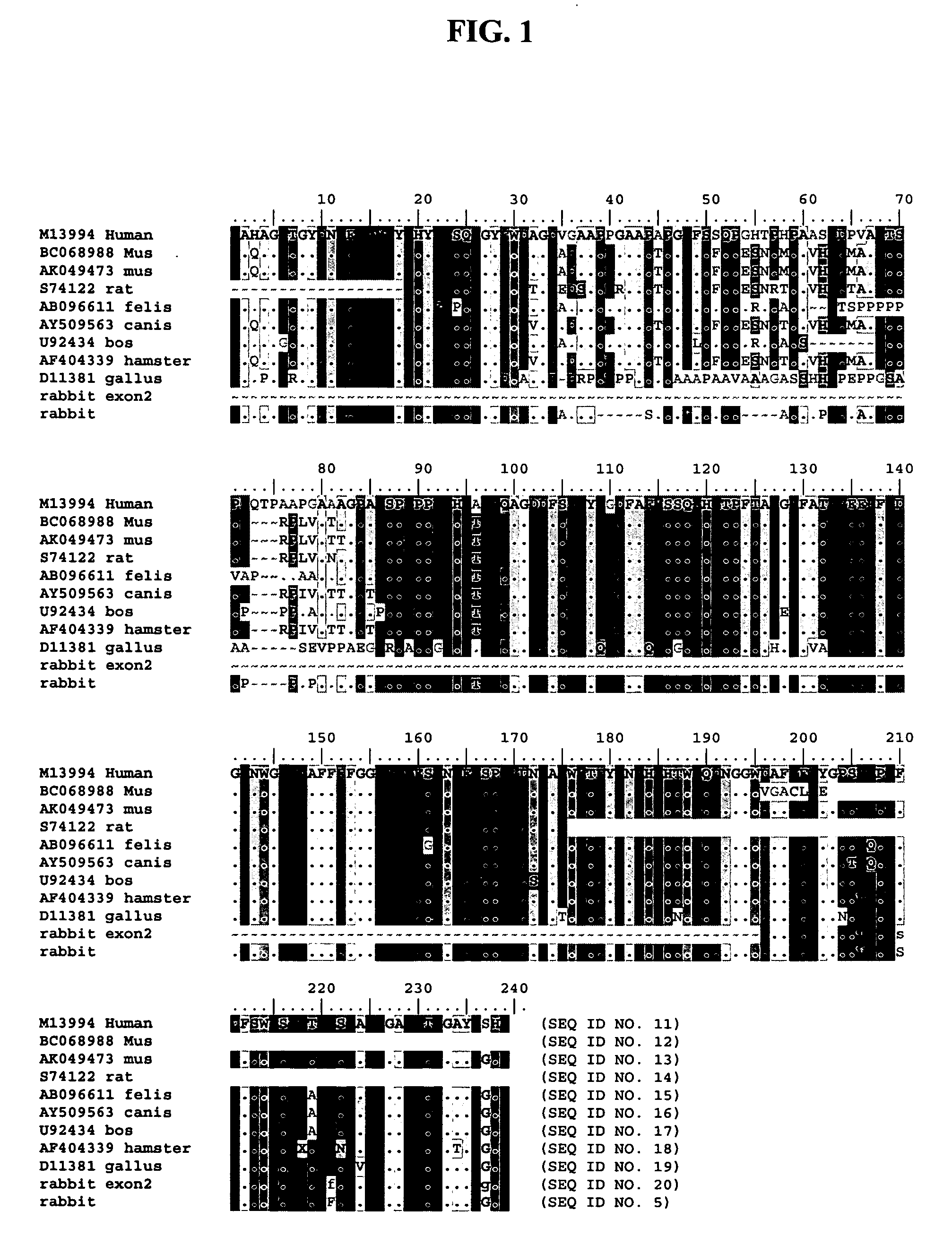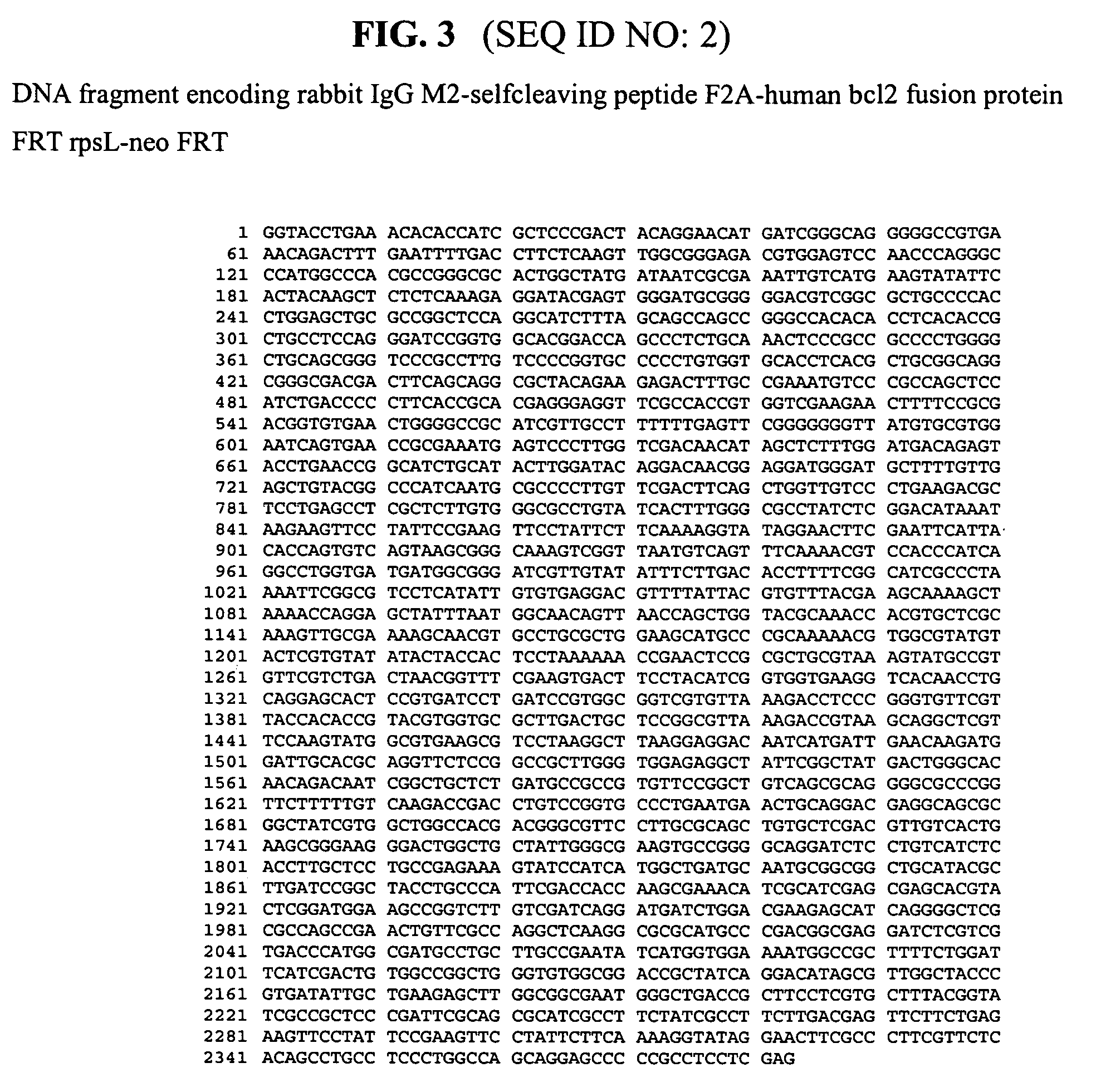Suppression of B-cell apoptosis in transgenic animals expressing humanized immunoglobulin
a technology of humanized immunoglobulin and transgenic animals, which is applied in the direction of immunological disorders, drug compositions, peptides, etc., can solve the problems of apoptosis inhibitors being used, and achieve the effects of enhancing the expression of an exogenous immunoglobulin, enhancing the survival of exogenous b cells and exogenous immunoglobulin production
- Summary
- Abstract
- Description
- Claims
- Application Information
AI Technical Summary
Benefits of technology
Problems solved by technology
Method used
Image
Examples
example 1
[0139] Construction of a Apoptosis-Inhibitor Expression Vector with Human bcl-2
[0140] Screening of rabbit genomic BAC libraries resulted in the identification of two BACs (179L1 and 19602; Gene Bank Accession Nos: AY495827, and AY495828, respectively) containing rabbit light chain K1 gene segments.
[0141] For the construction of a B-cell specific apoptosis-inhibitor expression vector, BAC AY495827 was modified by homologous recombination in E. coli (ET cloning: E. Chiang Lee et al., Genomics 73, 56-65 (2001); Daiguan Yu et al., PNAS 97, 5978-5983 (2000); Muyrers et al., Nucleic Acids Research 27, 1555-1557 (1999); Zhang et al., Nature Biotechnology 18, 1314-1317(2000)) and nucleotides 1-107795 and 142832-205141 were deleted. A synthetic human bcl-2 gene, under control of the kappa 1 promoter from AY495828 (pos. 114284-114570) further connected to the rabbit beta globin polyA sequence, was synthesized. Downstream, a gentamycin selection cassette flanked by FRT-sites was introduced b...
example 2
[0142] Construction of a Apoptosis-Inhibitor Expression Vector with Mouse bcl-2
[0143] Screening of a rabbit genomic BAC libraries resulted in the identification of two BACs (179L1 and 196O2; Gene Bank Accession Nos: AY495827, and AY495828, respectively) containing rabbit light chain K1 gene segments.
[0144] For the construction of a B-cell specific apoptosis-inhibitor expression vector, BAC AY495827 was modified by homologous recombination in E. coli (ET cloning: (E. Chiang Lee et al., Genomics 73, 56-65 (2001); Daiguan Yu et al., PNAS 97, 5978-5983 (2000); Muyrers et al., Nucleic Acids Research 27, 1555-1557 (1999); Zhang et al., Nature Biotechnology 18, 1314-1317(2000) and nucleotides 1-107795 and 142832-205141 were deleted. A synthetic mouse bcl-2 gene under the control of the kappa 1 promoter from AY495828 (pos. 114284-114570), further connected to the rabbit beta globin polyA sequence, was synthesized. Downstream, a gentamycin selection cassette flanked by FRT-sites was introd...
example 3
[0145] Construction of a Human(ized) Heavy Chain Locus Encoding a Fusion Protein Consisting of the Membrane Forms of IgM and IgG. a 2A Self-Cleaving Peptide, and Apoptosis-Inhibitor
[0146] BAC and fosmid clones containing rabbit immunoglobulin heavy chain locus sequences were isolated from genomic DNA libraries using probes specific for the constant, variable, and joining gene segments or the 3′ enhancer region. Isolated BACs and fosmid Fos15B were sequenced (Genebank acc. No. AY386695, AY386696, AY386697, AY386698). The J and Cμ regions of AY386695 and the C□ region of AY386696 were exchanged with corresponding human counterparts by homologous recombination in E. coliby ET cloning (E. Chiang Lee et al., Genomics 73, 56-65 (2001); Daiguan Yu et al., PNAS 97, 5978-5983 (2000); Muyrers et al., Nucleic Acids Research 27, 1555-1557 (1999); Zhang et al., Nature Biotechnology 18, 1314-1317(2000)).
[0147] The four BACs were recombined by in vitro ligation and Cre-mediated recombination to ...
PUM
| Property | Measurement | Unit |
|---|---|---|
| concentrations | aaaaa | aaaaa |
| concentrations | aaaaa | aaaaa |
| nucleic acid | aaaaa | aaaaa |
Abstract
Description
Claims
Application Information
 Login to View More
Login to View More - R&D
- Intellectual Property
- Life Sciences
- Materials
- Tech Scout
- Unparalleled Data Quality
- Higher Quality Content
- 60% Fewer Hallucinations
Browse by: Latest US Patents, China's latest patents, Technical Efficacy Thesaurus, Application Domain, Technology Topic, Popular Technical Reports.
© 2025 PatSnap. All rights reserved.Legal|Privacy policy|Modern Slavery Act Transparency Statement|Sitemap|About US| Contact US: help@patsnap.com



